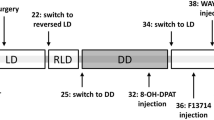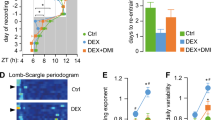Abstract
Neonatal treatment with monoamine reuptake inhibitors results in a constellation of neurobehavioral alterations in adult rats that may model human depression. Since alterations in circadian rhythmicity have been reported in both depressed patients and in animal depression models, the present study examined the effects of neonatal desipramine treatment (5.0 mg/kg SC from postnatal day 7 through 22) on free-running circadian drinking rhythms. Rhythmicity was examined in constant darkness (DD), constant light (LL), and during adult desipramine treatment (0.25 mg/ml via the drinking water). Compared with saline-treated controls, neonatal desipramine lengthened free-running period in DD, blunted the period-altering effect of LL, and potentiated the period-altering effect of adult desipramine treatment. Neonatal desipramine treatment also increased circadian amplitude and spectral magnitude, but did not modify the effects of light or adult desipramine on these parameters. These results provide further evidence that behavioral depression is associated with alterations in circadian rhythmicity, and are consistent with the hypothesis that such relationships are mediated by brain monoaminergic systems.
Similar content being viewed by others
References
Amir S, Schiavetto A (1990) Neonatal handling reduces the amplitude of the daily temperature rhythm in the rat. Soc Neurosci Abstr 16:1334
De Ceballos ML, Benedi A, Urdin C, Del Rio J (1985) Prenatal exposure of rats to antidepressant drugs down-regulates beta-adrenoceptors and 5-HT2 receptors in cerebral cortex. Neuropharmacology 24:947–952
Duncan WC, Wehr TA (1987) Pharmacological and non-pharmacological chronotherapies of depression. Annu Rev Chronopharmacol 4:137–170
Edgar DM, Martin CE, Dement WC (1991) Activity feedback to the mammalian circadian pacemaker: influence on observed measures of period length. J Biol Rhythms 6:185–199
Enginar N, Eroglu L (1990) The long term clonidine treatment induced behavioral depression in rats. Pol J Pharmacol Pharm 43:409–415
Fernandez-Pardal J, Hilakivi LA (1989) Effect of low alcohol dose on behavioral “despair” in rats neonatally treated with anti-depressant drugs. Alcohol 6:93–95
Healy D, Williams JMG (1988) Dysrhythmia, dysphoria, and depression: the interaction of learned helplessness and circadian dysrhythmia in the pathogenesis of depression. Psychol Bull 103:163–178
Hilakivi LA, Hilakivi I (1987) Increased adult behavioral “despair” in rats neonatally exposed to desipramine or zimeldine: an animal model of depression? Pharmacol Biochem Behav 28:367–369
Hilakivi LA, Sinclair JD (1986) Effects of neonatal clomipramine treatment on adult alcohol drinking in the AA and ANA rat lines. Pharmacol Biochem Behav 24:1451–1455
Hilakivi LA, Stenberg D, Sinclair JD, Kiianmaa K (1987) Neonatal desipramine or zimeldine treatment causes long-lasting changes in brain monoaminergic systems and alcohol related behavior in rats. Psychopharmacology 91:403–409
Hilakivi LA, Taira T, Hilakivi I (1988) Early postnatal deprivation of active sleep with desipramine or zimeldine impairs later behavioural reactivity to auditory stimuli in rats. Acta Physiol Scand 132:191–198
Hilakivi-Clarke LA, Turkka J, Lister RG, Linnoila M (1991) Effects of early postnatal handling on brain beta-adrenoceptors and behavior in tests related to stress. Brain Res 542:286–292
Kripke DF, Mullaney DJ, Gabriel S (1985) The chronopharmacology of antidepressant drug. Annu Rev Chronopharmacol 2:275–289
Lewy AJ, Sack RL, Miller S, Hoban TM (1987) Antidepressant and circadian phase-shifting effects of light. Science 235:352–354
Lumia AR, Teicher MH, Salchli F, Ayers E, Possidente B (1992) Olfactory bulbectomy as a model for agitated hyposerotonergic depression. Brain Res 587:181–185
Mirmiran M, van de Poll NE, Corner HG, Van Oyen H, Boer G (1981) Suppression of active sleep by chronic treatment with clomipramine during early postnatal development: effects on adult sleep and behavior in the rat. Brain Res 204:129–146
Mirmiran M, Brenner E, Van der Gugten J, Swaab DF (1985) Neurochemical and electrophysiological disturbances mediate developmental behavioral alterations produced by medicines. Neurobehav Toxicol Teratol 7:677–683
Mrosovsky N, Reebs SG, Honrado GI, Salmon PA (1989) Behavioural entrainment of circadian rhythms. Experientia 45:696–702
Pare WP (1989) Stress ulcer susceptibility and depression in Wistar Kyoto (WKY) rats. Physiol Behav 46:993–998
Possidente B, Lumia AR, McGinnis MY, Teicher MH, deLemos E, Sterner L, Deros L (1990) Olfactory bulb control oc circadian activity rhythm in mice. Brain Res 513:325–328
Possidente B, Lumia AR, McEldowney S, Rapp M (1992) Fluoxetine shortens circadian period for wheel running activity in mice. Brain Res Bull 28:629–631
Rosenwasser AM (1989) Effects of chronic clonidine administration and withdrawal on free-running circadian activity rhythms. Pharmacol Biochem Behav 33:291–297
Rosenwasser AM (1990) Free-running circadian activity rhythms during long-term clonidine administration in rats. Pharmacol Biochem Behav 35:35–39
Rosenwasser AM (1992) Circadian rhythms and depression: animal models? Light Treat Biol Rhythms 4:35–39
Rosenwasser AM (1993) Circadian drinking rhythms in SHR and WKY rats: effects of increasing light intensity. Physiol Behav 53:1035–1041
Rosenwasser AM, Plante L (1993) Circadian activity rhythms in SHR and WKY rats: strain differences and effects of clonidine. Physiol Behav 53:23–29
Shioiri T, Takahashi K, Yamada N, Takahashi S (1991) Motor activity correlates negatively with free-running period, while positively with serotonin contents in SCN in free-running rats. Physiol Behav 49:779–786
Shiromani PJ, Klemfuss H, Lucero S, Overstreet DH (1991) Diurnal rhythm of core body temperature is phase advanced in a rodent model of depression. Biol Psychiatry 29:923–930
Shiromani PJ, Schwartz WJ, Overstreet DH (1992) Free-running period of the circadian drinking rhythm is shorter in rats with an upregulated central cholinergic system. Sleep Res 21:388
Stewart KT, Rosenwasser AM, Hauser H, Volpicelli JR, Adler NT (1990) Circadian rhythmicity and behavioral depression I: effects of stress. Physiol Behav 48:149–155
Teicher MH, Lawrence JM, Barber NI, Finklestein SP, Lieberman HR, Baldessarini RJ (1988) Increased activity and phase-delay in circadian motility rhythms in geriatric depression. Arch Gen Psychiatry 45:913–917
Teicher MH, Barber NI, Lawrence JM, Baldessarini RJ (1989) Motor activity and antidepressant drugs: a proposed approach to categorizing depression syndromes and their animal models. In: Koob GF, Ehlers CL, Kupfer DJ (eds) Animal models of depression. Birkhauser, Boston Mass., pp 135–161
Tominaga K, Shibata S, Ueki S, Watanabe S (1992) Effects of 5HT-1a receptor agonists on the circadian rhythm of wheel-running activity in hamsters. Eur J Pharmacol 24:79–84
Turek FW (1989) Effects of stimulated physical activity on the circadian pacemaker of vertebrates. J Biol Rhythms 4:135–147
Velasquez-Moctezuma J, Ruiz OD (1992) Neonatal treatment with clomipramine increased immobility in the forced swim test: an attribute of animal models of depression. Pharmacol Biochem Behav 42:737–739
Vogel G, Neill D, Hagler M, Kors D (1990) A new animal model of endogenous depression: a summary of present findings. Neurosci Biobehav Rev 14:85–91
Vogt LJ, Rosenwasser AM (1992) Circadian phase-shifting induced by clonidine injections in Syrian hamsters. Soc Res Biol Rhythms Abstr 3:109
Wakshlak A, Weinstock M (1990) Neonatal handling reverses behavioral abnormalities induced in rats by prenatal stress. Physiol Behav 48:289–292
Watts AG (1991) The efferent projections of the suprachiasmatic nucleus: anatomical insights into the control of circadian rhythms. In: Klein DC, Moore RY, Reppert SM (eds) Suprachiasmatic nucleus: the mind's clock. Oxford, New York, pp 77–106
Wehr TA, Gillin JC, Goodwin FK (1983) Sleep and circadian rhythms in depression. In: Chase M, Weitzman ED (eds) Sleep disorders: basic and clinical research. Spectrum, New York, pp 195–226
Wollnik F (1992) Effects of chronic administration and withdrawal of antidepressant agents on circadian activity rhythms in rats. Pharmacol Biochem Behav 43:549–561.
Author information
Authors and Affiliations
Rights and permissions
About this article
Cite this article
Rosenwasser, A.M., Hayes, M.J. Neonatal desipramine treatment alters free-running circadian drinking rhythms in rats. Psychopharmacology 115, 237–244 (1994). https://doi.org/10.1007/BF02244777
Received:
Revised:
Issue Date:
DOI: https://doi.org/10.1007/BF02244777




